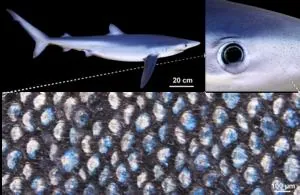
Revolutionary Discovery: Blue Sharks' Secret to Dynamic Color Change!
2025-07-09
Author: William
Unlocking Nature's Color Palette
A groundbreaking study has unveiled an astonishing aspect of blue sharks (Prionace glauca) — their skin not only showcases their vibrant blue color but also hints at an incredible ability to change hues. Dr. Viktoriia Kamska, a post-doctoral researcher at City University of Hong Kong, emphasizes the rarity of blue in the animal kingdom and the unique evolutionary strategies creatures have developed to produce it.
The Secret Behind the Blue
Researchers found that the striking blue color of blue sharks is attributed to the unique pulp cavities within their tooth-like scales, known as dermal denticles. These cavities are home to guanine crystals, which reflect blue light, and melanin-containing vesicles called melanosomes that absorb other wavelengths. Dr. Kamska describes the combination as being like bags of mirrors and bags of absorbers, designed to work in perfect harmony.
Tiny Structural Adjustments, Big Color Changes
Professor Mason Dean highlights the remarkable potential of these structural materials: when combined, they allow the sharks not only to produce brilliant colors but also to alter them. By observing slight variations in the arrangement of guanine crystals, researchers can predict how these microscopic changes can influence the overall coloration of the shark.
Cutting-Edge Technology at Work
The study employed an array of advanced techniques such as optical and electron microscopy, spectroscopy, and a range of imaging technologies to dissect and understand the intricate nanostructures responsible for the shark's coloration. Professor Dean notes that while color is often viewed at the visible level, this research dives deep into the nanometer scale, where structural colors are truly formed.
Color Shift Controlled by Environment?
Findings suggest that the distances between guanine crystals can be influenced by environmental factors, potentially allowing sharks to camouflage themselves more effectively. Deeper swimming may cause increased water pressure, compressing these crystals and darkening the shark's color to blend with its surroundings.
Implications for Bio-Inspired Engineering
This discovery not only sheds light on the anatomy and evolution of sharks but also opens doors for innovative applications in bio-inspired engineering. Professor Dean discusses how these multifunctional denticles offer hydrodynamic benefits and may now serve to alter coloration, raising the prospect of developing materials that reduce environmental impact.
Towards a Sustainable Future
Dr. Kamska reveals that structural coloration could provide a greener alternative to chemical dyes, reducing toxicity and pollution in manufacturing processes. As advancements in nanofabrication evolve, they pave the way for deeper insights into how structure influences function across various species, especially as sharks and rays diverged from bony fishes millions of years ago.
Future Research for an Aquatic Evolutionary Path
The next steps involve studying these mechanisms in blue sharks in their natural habitats, potentially revolutionizing our understanding of marine life and inspiring eco-friendly innovations. As noted, this extraordinary discovery not only enhances our knowledge of marine biology but also highlights the need for sustainable practices in technology.









 Brasil (PT)
Brasil (PT)
 Canada (EN)
Canada (EN)
 Chile (ES)
Chile (ES)
 Česko (CS)
Česko (CS)
 대한민국 (KO)
대한민국 (KO)
 España (ES)
España (ES)
 France (FR)
France (FR)
 Hong Kong (EN)
Hong Kong (EN)
 Italia (IT)
Italia (IT)
 日本 (JA)
日本 (JA)
 Magyarország (HU)
Magyarország (HU)
 Norge (NO)
Norge (NO)
 Polska (PL)
Polska (PL)
 Schweiz (DE)
Schweiz (DE)
 Singapore (EN)
Singapore (EN)
 Sverige (SV)
Sverige (SV)
 Suomi (FI)
Suomi (FI)
 Türkiye (TR)
Türkiye (TR)
 الإمارات العربية المتحدة (AR)
الإمارات العربية المتحدة (AR)